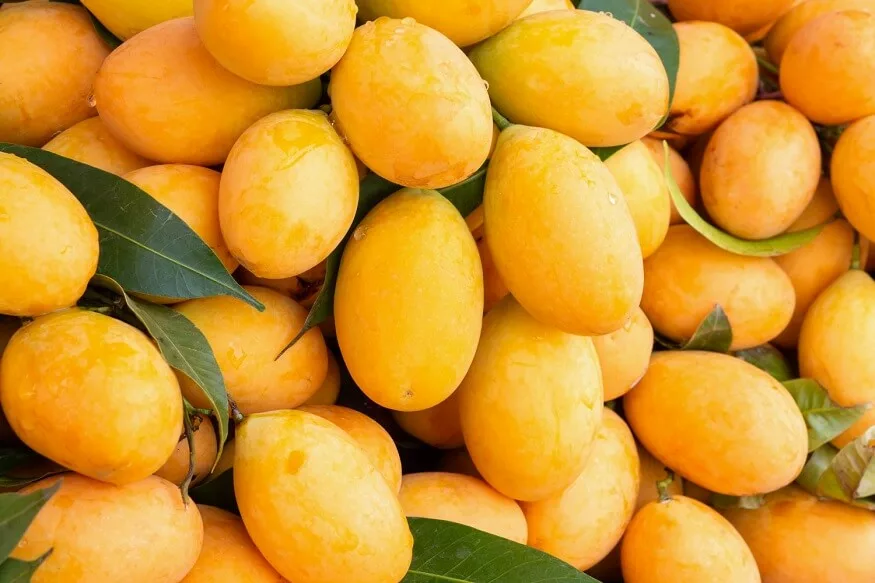Mango is often celebrated as the ‘king of fruits,’ not only for its delicious taste but also for its numerous health benefits. Introducing mangoes into a child’s diet from an early age can provide them with essential nutrients and vitamins.
This article aims to educate about the importance and benefits of mangoes in a kid’s diet and how parents can effectively communicate this nutritional value to their children.
Also read : 15 Best Healthy Foods For Blood Circulation
Nutritional Profile of Mangoes
Mangoes are a rich source of
- Vitamin C
- Vitamin A
A cup serving (225 grams) of mango provides
- 105 calories.
- 76% of the daily recommended intake (DRI) of Vitamin C
- 25% of the DRI of Vitamin A
- 3 grams of dietary fibre (12% of DRI)
- 277 mg of Potassium (6% of the DRI)
- 4 grams of proteins
- 6 grams of fat
Vitamin C is known to aid:
- Immune function
- Collagen synthesis
- Good vision
- Skin health
- Normal growth
- Iron Absorption
Vitamin A is known to aid:
- Eye health
- Boosts the immune system
Fibre helps in
- Maintaining a healthy digestive system
- Regulating blood glucose levels.
Potassium helps in:
- Maintaining normal body functions.
- Supporting optimal nerve and muscle cell function
- Balancing bodily fluids.
Mangoes also contain other vital vitamins and minerals such as Vitamin E, Vitamin K, Vitamin B5, Vitamin B6, Copper, and Magnesium, albeit in lesser proportions.
Teaching Kids about the Nutritional Value of Mangoes
Teaching kids about the nutrition in their food is as vital as encouraging a healthy diet. It helps them make better food choices as they grow. Below are some simple ways we can introduce kids to the nutritional value of mangoes:
1) Involving them in the kitchen
While preparing a mango smoothie or a mango salad, parents can talk about the health benefits of the ingredients used. Children are more likely to remember and understand this information when they see it put into practice. As the meal is cooked, discuss the various benefits of mangoes.
2) Using visuals
Parents can get creative with teaching materials – using pictures, infographics, or even fun facts to explain the nutritional benefits of mangoes. For instance, telling a child that eating mangoes can make their skin glow or strengthen their immunity to prevent common illnesses like colds can be impactful.
Also read : Foods That Increase Your Metabolism In Children
3) Visit to a farm
Visiting a local farm can be an educational trip where kids can see and learn about different fruits, including mangoes, their nutrient content, and their benefits.
4) Using art
A mango-themed colouring exercise can serve as a platform for teaching about the different vitamins and minerals it contains. As they colour, they can engage verbally about the benefits such as improved digestion, a boost of immunity, and overall good health.
5) Storybooks
Storybooks and children’s encyclopaedias can be colourful sources of knowledge. It is easier for kids to understand when they can visually associate mangoes’ benefits with interesting characters and narratives.
6) Technology
Leverage technology to further the education on mango nutrition. Thanks to the digital age, numerous online resources, including educational videos and interactive games, highlight the benefits of different fruits, including mangoes. Websites like Kids Health or Fun2Learn can supplement your efforts.
Also read : Protein-Rich foods for good health of children
Ways to consume
In a time when children tend to lean more towards fast foods and sugary drinks, instilling a love for fruits like mangoes can combat unhealthy eating habits. Mangoes have natural sugars that cater to children’s love for sweetness, substituting unhealthy processed sugars with beneficial nutrients.
Mangoes are also versatile and can be included in a child’s diet in various forms. Below are some options:
1) Mango smoothie bowl
Blend mangoes, bananas, and almond milk into a creamy, smoothie-like texture. Add a variety of healthy toppings like berries, nuts, and seeds for extra nutrition.
2) Parfait
Layer mango chunks with vanilla yoghurt and granola for a tasty and nutritious parfait.
3) Mango Pancakes
Make a standard pancake batter and add a puree of ripe mangoes. Serve warm with a drizzle of honey or maple syrup and a dollop of whipped cream.
4) Popsicles
Puree mangoes and mix them with a bit of water or coconut milk. Pour the mixture into popsicle moulds and freeze for homemade mango popsicles.
5) Mango Salsa
Mango salsa is a delightful combination of diced mangoes, red bell pepper, chopped red onion, and cilantro with a hint of tanginess from the lime juice. It is a perfect accompaniment for various dishes or simply enjoyed with chips.
6) Mango-wrapped banana bites
Wrap banana pieces with mango slices until you have a plate full of mango-wrapped banana bites. Place the bites in the refrigerator for about 30 minutes to chill and firm up. Serve.
7) Mango puddings
Blend mangoes with coconut milk and a little sugar. Heat until it thickens and cool it down before serving.
8) Mango energy balls
Mango energy balls comprise dried mangoes, rolled oats, almond butter, and a touch of honey. Blend all the ingredients and roll them into balls. They make great after-school treats.
Also read : The Importance of Good Nutrition for Children
At EuroSchool we believe that while fruits are a necessary part of a balanced diet, educating children about their nutritional value enhances their understanding of healthy eating habits. Hence by incorporating mangoes into EuroSchool’s meal plans and educational activities, we ensure children appreciate mangoes not just for their taste but their nutritional value.









